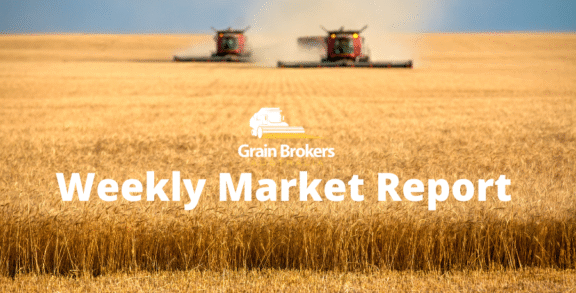Canadian grain production is set for a significant rebound this season on the back of a sharp improvement in weather conditions across most of the Prairies, according to Agriculture and Agri-Food Canada’s (AAFC) latest Outlook for Principal Field Crops.
However, this season has had its hardships as well, and above-average, well-timed rainfall is still required in many regions for the balance of the growing season to achieve average yields. Crop conditions are generally favourable in the Western Prairies, with recent rain events reducing the drought-affected areas, and the Eastern Prairies are getting back on track after excessive moisture delayed planting in many regions.
As of July 12, drought is confined to a small area in the southwestern Prairies with good June rainfall eliminating all areas of extreme drought. Currently, only 39 per cent of Canadian agricultural land is suffering some form of dryness or drought, down from 100 per cent since the beginning of the year.
According to the AAFC report, the total area seeded to grain crops has remained relatively static at 31.45 million hectares compared to 31.53Mha last year. But a massive jump in the average yield will see total grain and oilseed output jump by more than 34 per cent year-on-year to 87.3 million metric tonne.
However, Canadian farmers have substantially increased the area sown to wheat at the expense of coarse grains, oilseeds and pulses in the 2022/23 season. The total wheat area has increased by nine per cent to 10.35Mha compared to last year, 1.5 per cent higher than the original seeding intentions released back in April.
The area planted to spring wheat makes up almost three-quarters of the total wheat area at 7.37Mha. Next in line is durum wheat with 2.43Mha, and winter wheat has a minor slice of the pie at 477,000 hectares. The most common wheat class in Canada is Canadian Western Red Spring wheat which is planted into approximately 78 per cent of the total wheat area (excluding durum).
Assuming 98 per cent of the planted area is harvested, and we see a return to near average yield of 3.33 metric tonne per hectare, AAFC is pegging the Canadian wheat crop at 33.72MMT, an increase of 55.7 per cent on the 2021/22 crop. If that estimate proves correct at the conclusion of harvest, it would be the third biggest Canadian wheat crop on record behind 2013 with 37.59MMT and 2020 with 35.18MMT.
Canada is one of the world’s major wheat exporters. After a major hiccup in the 2021/22 marketing year, AAFC anticipates shipments will return to more normal levels in the 2022/23 marketing year. The current estimate of 22.4MMT, including 4.4MMT of durum, is more than 51 per cent higher season-on-season. This seems conservative given port capacity, the strong global demand and much higher carry-out stocks. However, Canadian export prices are high at the moment due to production uncertainty, the extremely tight old crop balance sheet and escalating domestic transport costs.
Barley production is also set to increase year-on-year, but AAFC calls the planted area down more than 15 per cent to 2.85Mha. This is the lowest area planted to barley in the last four years, is six per cent lower than the March planting intentions and more than one per cent lower than the five-year average. Alberta and Saskatchewan are the two top barley producing provinces, and the seeded area is down eight per cent and 25 per cent, respectively. On the other hand, plantings in Manitoba are three per cent higher than in the 2021/22 season.
Using normal abandonment of around 10 per cent and a slightly above average yield of 3.49MT/ha, production is forecast to increase to 9.06MMT in 2022/23. This is 30 per cent higher than the 6.95MMT produced last harvest and is two per cent higher than the five-year average. With the increase in supply, AAFC forecasts Canadian barley exports to increase from 2.59MMT in the 2021/22 marketing year to 3.05MMT in 2022/23.
Canada is the world’s biggest canola producer, and production is expected to jump substantially after a horror harvest in 2021. While the seeded area is estimated to be 4.7 per cent lower at 8.67Mha, yields are forecast to jump from 1.4MT/ha last year to 2.14MT/ha in this year’s harvest. The Manitoba area is slightly lower than early season indications, but farmers in Saskatchewan and Alberta have gone harder on canola than initially intended.
Assuming abandonment of less than one per cent and a five-year average yield of 2.14MT/ha, AAFC is forecasting production to rebound from 12.6MMT last year to 18.4MMT this year. That would be the seventh highest canola crop on record, with the six higher years all occurring since 2013. With the higher output comes a recovery in the export program, and shipments are projected to jump almost 75 per cent to 9MMT.
Lentils and dry peas (field peas) are the main pulse crops in Canada, and production of both are expected to recover after last season’s drought. The area planted to lentils has remained stable year-on-year but a 52 per cent jump in yield to 1.43MT/ha will see production climb by around 56 per cent to 2.46MMT. The dry pea area has dropped by around 12 per cent, but a 64 per cent hike in yield to 2.47MT/ha will see production up by 46 per cent to 3.3MMT.
The biggest challenge to the AAFC production outlook will be a continuation of the hot and dry weather seen through much of July. Several Canadian analysts are already questioning some of the AAFC production forecasts, particularly wheat. Substantial rains are required to replenish severely depleted soil moisture reserves, especially in the southwestern Prairies, as the crop matures and increased evapotranspiration drives up moisture demand.
Call your local Grain Brokers Australia representative on 1300 946 544 to discuss your grain marketing needs.





